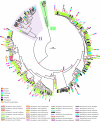Multiple-locus sequence typing and analysis of toxin genes in Bacillus cereus food-borne isolates
- PMID: 18083872
- PMCID: PMC2227710
- DOI: 10.1128/AEM.01495-07
Multiple-locus sequence typing and analysis of toxin genes in Bacillus cereus food-borne isolates
Abstract
In the present study we characterized 47 food-borne isolates of Bacillus cereus using multilocus sequence typing (MLST). Newly determined sequences were combined with sequences available in public data banks in order to produce the largest data set possible. Phylogenetic analysis was performed on a total of 296 strains for which MLST sequence information is available, and three main lineages--I, II, and III--within the B. cereus complex were identified. With few exceptions, all food-borne isolates were in group I. The occurrence of horizontal gene transfer (HGT) among various strains was analyzed by several statistical methods, providing evidence of widespread lateral gene transfer within B. cereus. We also investigated the occurrence of toxin-encoding genes, focusing on their evolutionary history within B. cereus. Several patterns were identified, indicating a pivotal role of HGT in the evolution of toxin-encoding genes. Our results indicate that HGT is an important element in shaping the population structure of the B. cereus complex. The results presented here also provide strong evidence of reticulate evolution within the B. cereus complex.
Figures



References
-
- Agata, N., M. Ohta, Y. Arakawa, and M. Mori. 1995. The bceT gene of Bacillus cereus encodes an enterotoxin protein. Microbiology 141:983-988. - PubMed
-
- Altschul, S. F., W. Gish, W. Miller, E. W. Myers, and D. J. Lipman. 1990. Basic local alignment search tool. J. Mol. Biol. 215:403-410. - PubMed
-
- Anonymous. 2004. Microbiology of food and animal feeding stuffs—horizontal method for enumeration of presumptive Bacillus cereus—colony-count technique at 30°C. Document ISO 7932. International Organization for Standardization, Geneva, Switzerland.
-
- Barker, M., B. Thakker, and F. G. Priest. 2005. Multilocus sequence typing reveals that Bacillus cereus strains isolated from clinical infections have distinct phylogenetic origins. FEMS Microbiol. Lett. 245:179-184. - PubMed
MeSH terms
Substances
Associated data
- Actions
- Actions
- Actions
- Actions
- Actions
- Actions
- Actions
- Actions
- Actions
- Actions
- Actions
- Actions
- Actions
- Actions
- Actions
- Actions
- Actions
LinkOut - more resources
Full Text Sources

